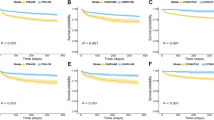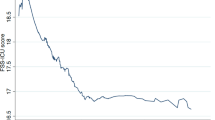Abstract
Background/Objectives:
Older malnourished patients experience increased surgical complications and greater morbidity compared with their well-nourished counterparts. This study aimed to assess whether nutritional status at hospital admission predicted clinical outcomes at 18 months follow-up.
Subjects/Methods:
A retrospective analysis of N=2076 patient admissions (65+ years) from two subacute hospitals, New South Wales, Australia. Analysis of outcomes at 18 months, according to nutritional status at index admission, was performed in a subsample of n=476. Nutritional status was determined within 72 h of admission using the Mini Nutritional Assessment (MNA). Outcomes, obtained from electronic patient records, included hospital readmission rate, total Length of Stay (LOS), change in level of care at discharge and mortality. Survival analysis, using a Cox proportional hazards model, included age, sex, Major Disease Classification, mobility and LOS at index admission as covariates.
Results:
At baseline, 30% of patients were malnourished and 53% were at risk of malnutrition. LOS was higher in malnourished and at risk, compared with well-nourished patients (median (interquartile range): 34 (21, 58); 26 (15, 41); 20 (14, 26) days, respectively; P<0.001). Hazard rate for death in the malnourished group is 3.41 (95% confidence interval: 1.07–10.87; P=0.038) times the well-nourished group. Discharge to a higher level of residential care was 33.1%, 16.9% and 4.9% for malnourished, at-risk and well-nourished patients, respectively; P⩽0.001).
Conclusion:
Malnutrition in elderly subacute patients predicts adverse clinical outcomes and identifies a need to target this population for nutritional intervention following hospital discharge.
This is a preview of subscription content, access via your institution
Access options
Subscribe to this journal
Receive 12 print issues and online access
$259.00 per year
only $21.58 per issue
Buy this article
- Purchase on Springer Link
- Instant access to full article PDF
Prices may be subject to local taxes which are calculated during checkout

Similar content being viewed by others
References
Butterworth C . The skeleton in the hospital closet. Nutr Today 1974; 9: 4–8.
Kagansky N, Berner Y, Koren-Morag N, Perelman L, Knobler H, Levy S . Poor nutritional habits are predictors of poor outcome in very old hospitalized patients. Am J Clin Nutr 2005; 82: 784–791.
Correia M, Isabel TD, Waitzberg DL . The impact of malnutrition on morbidity, mortality, length of hospital stay and costs evaluated through a multivariate model analysis. Clin Nutr 2003; 22: 235–239.
Brantervik ÅM, Jacobsson IE, Grimby A, Wallén TCE, Bosaeus IG . Older hospitalised patients at risk of malnutrition: correlation with quality of life, aid from the social welfare system and length of stay? Age Ageing 2005; 34: 444–449.
Visvanathan R, Macintosh C, Callary M, Penhall R, Horowitz M, Chapman I . The nutritional status of 250 older australian recipients of domiciliary care services and its association with outcomes at 12 months. J Am Geriatr Soc 2003; 51: 1007–1011.
Elia M . Nutrition and health economics. Nutr 2006; 22: 576–578.
Kondrup J, Allison SP, Elia M, Vellas B, Plauth M . ESPEN Guidelines for Nutrition Screening 2002. Clin Nutr 2003; 22: 415–421.
National Collaborating Centre for Acute Care. Nutrition Support in Adults. Oral Nutrition Support, Enteral Tube Feeding and Parenteral Nutrition. NICE Clinical Guideline 32, February, London: National Collaborating Centre for Acute Care, 2006.
Council of Europe. Food and nutritional care in hospitals: how to prevent undernutrition. In: Nutrition Programmes in Hospitals Group for the Committee of Experts on Nutrition FSaCH (edn, Council of Europe: Strasbourg, 2003.
Watterson C, Fraser A, Banks M, Isenring E, Miller M, Silvester C et al. Evidence based practice guidelines for the nutritional management of malnutrition in adult patients across the continuum of care. Nutr Diet 2009; 66: S1–S34.
Schindler K, Pernicka E, Laviano A, Howard P, Schütz T, Bauer P et al. How nutritional risk is assessed and managed in European hospitals: a survey of 21,007 patients findings from the 2007–2008 cross-sectional nutritionDay survey. Clin Nutr 2010; 29: 552–559.
Agarwal E, Ferguson M, Banks M, Batterham M, Bauer J, Capra S et al. Nutrition care practices in hospital wards: results from the Nutrition Care Day Survey 2010. Clin Nutr 2012; 31: 41–47.
Kaiser M, Bauer J, Ramsch C, Uter W, Guigoz Y, Cederholm T et al. Validation of the mini nutritional assessment short-form (MNA-SF): a practical tool for identification of nutritional status. J Nutr Health Aging 2009; 13: 782–788.
Fiatarone MA, O'Neill EF, Ryan ND, Clements KM, Solares GR, Nelson ME et al. Exercise training and nutritional supplementation for physical frailty in very elderly people. N Engl J Med 1994; 330: 1769–1775.
Milne AC, Avenell A, Potter J . Meta-analysis: protein and energy supplementation in older people. Ann Intern Med 2006; 144: 37–48.
Milne AC, Avenell A, Potter J . Improved food intake in frail older people. BMJ 2006; 332: 1165–1166.
Potter JM, Roberts MA, McColl JH, Reilly JJ . Protein energy supplements in unwell elderly patients—a randomized controlled trial. JPEN J Parenter Enteral Nutr 2001; 25: 323–329.
Delmi M, Rapin CH, Bengoa JM, Delmas PD, Vasey H, Bonjour JP . Dietary supplementation in elderly patients with fractured neck of the femur. Lancet 1990; 335: 1013–1016.
Charlton KE, Nichols C, Bowden S, Lambert K, Barone L, Mason M et al. Older rehabilitation patients are at high risk of malnutrition: evidence from a large Australian database. J Nutr Health Aging 2010; 14: 622–628.
Australasian Faculty of Rehabilitation Medicine (AFRM). Standards 2005—Adult Rehabilitation Medicine Services in Public and Private Hospitals: Sydney, 2005.
Guigoz Y, Vellas B, Garry PJ . Mini nutritional assessment: a practical assessment tool for grading the nutritional state of elderly patients. In: Guigoz Y, Vellas B, Garry PJ, Albarede JL (eds) Facts Research in Gerontology. vol 4 (Suppl 2). Serdi: Paris, 1994, pp 15–59.
Mini Nutritional Assessment (MNA): Research and Practice in the Elderly, Lausanne. Nestle 1999.
Kyle UG, Genton L, Pichard C . Hospital length of stay and nutritional status. Curr Opin Clin Nutr Metab Care 2005; 8: 397–402.
Amaral TF, Matos LC, Tavares MM, Subtil A, Martins R, Nazaré M et al. The economic impact of disease-related malnutrition at hospital admission. Clin Nutr 2007; 26: 778–784.
Inzitari M, Doets E, Bartali B, Benetou V, Di Bari M, Visser M et al. Nutrition in the age-related disablement process. J Nutr Health Aging 2011; 15: 599–604.
Bauer JM, Kaiser MJ, Anthony P, Guigoz Y, Sieber CC . The mini nutritional assessment®-its history, today's practice, and future perspectives. Nutr Clin Pract 2008; 23: 388–396.
Weekes CE, Spiro A, Baldwin C, Whelan K, Thomas JE, Parkin D et al. A review of the evidence for the impact of improving nutritional care on nutritional and clinical outcomes and cost. J Hum Nutr Diet 2009; 22: 324–335.
Walton K, Williams P, Tapsell L, Batterham M . Rehabilitation inpatients are not meeting their energy and protein needs. E SPEN Eur E J Clin Nutr Metab 2007; 2: e120–e126.
Duncan DG, Beck SJ, Hood K, Johansen A . Using dietetic assistants to improve the outcome of hip fracture: a randomised controlled trial of nutritional support in an acute trauma ward. Age Ageing 2006; 35: 148–153.
Nijs KAND, De Graaf C, Siebelink E, Blauw YH, Vanneste V, Kok FJ et al. Effect of family-style meals on energy intake and risk of malnutrition in Dutch nursing home residents: a randomized controlled trial. J Gerontol A Biol Sci Med Sci 2006; 61: 935–942.
Millen BE, Ohls JC, Ponza M, McCool AC . The Elderly Nutrition Program: an effective national framework for preventive nutrition interventions. J Am Diet Assoc 2002; 102: 234–240.
Salmon M, Bridges J . Waiting for dinner: elderly on the waiting list for home-delivered meals. Mississippi State. MS: Southern Rural Development Center. 2005. Report No. 9.
Fethke CC, Smith IM . The critical post-discharge period for older patients leaving a hospital. J Gerontol Soc Work 1991; 16: 93–105.
Anyanwu UO, Sharkey JR, Jackson RT, Sahyoun NR . Home food environment of older adults transitioning from hospital to home. J Nutr Gerontol Geriatr 2011; 30: 105–121.
Payette H, Gray-Donald K, Cyr R, Boutier V . Predictors of dietary intake in a functionally dependent elderly population in the community. Am J Public Health 1995; 85: 677–683.
Milosavljevic M, Bowden S, Mason S, Barone L, Williams P, Noble G . The dietetic management of malnutrition in and out of hospitals; is it time dietitians COMMIT to a long term model of care? Nutr Diet 2011; 68: 6.
Acknowledgements
No external sponsorship was received for this study. A summer scholarship from the Smart Foods Centre, University of Wollongong was provided to CN. Joanna Russell is thanked for editorial assistance.
Author information
Authors and Affiliations
Corresponding author
Ethics declarations
Competing interests
Karen Charlton was a member of the International MNA Revision Group and attended a workshop in Switzerland in October 2008 that was fully funded by Nestle Nutrition Institute, Switzerland. She has received honoraria from Nestle Healthcare Nutrition (Australia) for participation in a Malnutrition in the Elderly Advisory Board and for educational presentations to general practitioners and geriatricians on the topic of malnutrition screening. The other authors declare no conflict of interest.
Additional information
Contributors: KEC—conceptualisation of study design, data analysis and primary responsibility for writing the article; CN—data entry, data analysis and writing the article; SB—study design, data collection, entry and cleaning and data analysis; KL and LB—data collection, data entry and writing the article; SM—data collection and writing the article; MM—study design and writing the article; MB—statistical data analysis and editing.
Rights and permissions
About this article
Cite this article
Charlton, K., Nichols, C., Bowden, S. et al. Poor nutritional status of older subacute patients predicts clinical outcomes and mortality at 18 months of follow-up. Eur J Clin Nutr 66, 1224–1228 (2012). https://doi.org/10.1038/ejcn.2012.130
Received:
Revised:
Accepted:
Published:
Issue Date:
DOI: https://doi.org/10.1038/ejcn.2012.130
Keywords
This article is cited by
-
Predictive Value of Geriatric Nutritional Risk Index in Older Adult Cancer Patients
The Journal of nutrition, health and aging (2022)
-
A retrospective study of the incidence and characteristics of long-stay adult inpatients with hospital-acquired malnutrition across five Australian public hospitals
European Journal of Clinical Nutrition (2020)
-
Malnutrition risks and their associated factors among home-living older Chinese adults in Hong Kong: hidden problems in an affluent Chinese community
BMC Geriatrics (2019)
-
Effects of Nutrition Therapy in Older Stroke Patients Undergoing Rehabilitation: A Systematic Review and Meta-Analysis
The Journal of nutrition, health and aging (2019)
-
Economic evaluation of an extended nutritional intervention in older Australian hospitalized patients: a randomized controlled trial
BMC Geriatrics (2018)



